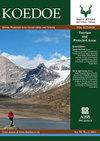The influence of fire presence and absence on grass species composition and species richness at Mountain Zebra National Park
IF 1.1
4区 环境科学与生态学
Q3 BIODIVERSITY CONSERVATION
引用次数: 0
Abstract
It is well known that fire is a common driver in many biomes and it plays a vital role in maintaining ecosystem functioning in many South African biomes. This ecosystem process is an important determinant of plant community composition and diversity, and can result in changes in structural composition and ecosystem functioning. The main objectives of this study are to determine the influence of fire on grass species richness, diversity and composition in Mountain Zebra National Park. Using satellite imagery, the park’s fire history was determined between 2000 and 2020. Eighty plots (approximately 20 m × 20 m; 100 m apart) were laid out purposively across different fire regimes. There was no significant difference in both species richness and diversity in burned and unburned sites. However, there was a difference in species composition between burned and unburned sites and between different fire frequencies. The unburned site had higher moribund material and unpalatable grasses compared to the burned area.Conservation implications: The results of this study will help in the completion of the fire management plan for the park which will enable conservation managers to make better decisions with regard to fire management in mountainous grassland at Mountain Zebra National Park. Consequently, this will lead to improved veld condition and vegetation structure.有无火对山斑马国家公园草地物种组成和物种丰富度的影响
众所周知,火灾是许多生物群落的共同驱动因素,它在维持许多南非生物群落的生态系统功能方面起着至关重要的作用。这一生态系统过程是植物群落组成和多样性的重要决定因素,可导致结构组成和生态系统功能的变化。本研究的主要目的是确定火灾对山斑马国家公园草地物种丰富度、多样性和组成的影响。利用卫星图像,确定了该公园在2000年至2020年之间的火灾历史。80个地块(约20米× 20米;相距100米),有目的地布置在不同的火区。烧地与未烧地的物种丰富度和多样性均无显著差异。然而,在不同的燃烧地点和不同的火灾频率之间,物种组成存在差异。与燃烧区相比,未燃烧区有更多的死亡物质和难食的草。保护意义:本研究的结果将有助于完成公园的火灾管理计划,使保护管理者能够更好地制定山斑马国家公园山地草原的火灾管理决策。因此,这将导致改善草原条件和植被结构。
本文章由计算机程序翻译,如有差异,请以英文原文为准。
求助全文
约1分钟内获得全文
求助全文
来源期刊

Koedoe
BIODIVERSITY CONSERVATION-
CiteScore
3.30
自引率
0.00%
发文量
10
审稿时长
20 weeks
期刊介绍:
Koedoe, with the subtitle ''African Protected Area Conservation and Science'', promotes and contributes to the scientific (biological) and environmental (ecological and biodiversity) conservation practices of Africa by defining the key disciplines that will ensure the existence of a wide variety of plant and animal species in their natural environments (biological diversity) in Africa.
 求助内容:
求助内容: 应助结果提醒方式:
应助结果提醒方式:


